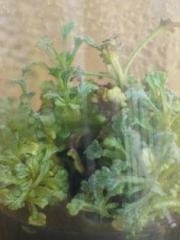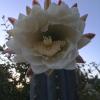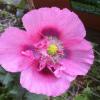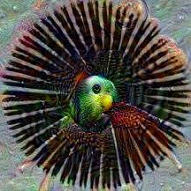Leaderboard
Popular Content
Showing content with the highest reputation on 04/06/13 in all areas
-
4 pointshttp://www.gizmodo.com.au/2013/06/scientists-revived-400-year-old-plants-that-could-help-us-live-on-mars/?utm_source=feedly Scientists Revived 400-Year-Old Plants That Could Help Us Live On Mars Ashley Feinberg 1 June 2013 10:00 AM A recently uncovered, perfectly preserved, 400-year-old plant specimen might be the answer to our increasingly important colonisation of other planets — and the preservation of the human race as a whole. You probably already know that human stem cells hold a vast, wildly exciting potential — both in terms of furthering our understanding of the human body and in saving countless lives. But did you know plants have their very own version of the industrious little cells, called bryophytes, that could prove just as important in saving humanity? That’s exactly what scientists have found and what’s gotten them so excited. Lead by Catherine La Farge, a team of researchers from the University of Alberta was exploring mosses around the Teardrop Glacier in the Canadian arctic archipelago when they discovered that portions of the (now rapidly receding) glacier were tinted an incongruous green. After taking the sample plant material back to her lab, the team ground up the specimens, placed them in potting soil, and watched with awe as they successfully regenerated from their 400-year-old parent material. As the glacier recedes at an astonishing rate of 3m-4m per year since 2004, scientists have gained access to an increasing amount of centuries-old plant life frozen in time. Every discovery up until now, though, has been flora of the vascular variety. But it’s this non-vascular sort that, though often overlooked, holds the key to understanding our past and our future. What’s a Bryophyte?Vascular plants are primarily defined by the existence of a xylem and a phloem, or in other words, the parts that suck up water and nutrients and send them shooting throughout the rest of the plant. Non-vascular plants, as all you keen observers may have already guessed, don’t have this system — they’re a far more simple breed. Made to freeze and dry out, they’re able to survive in conditions that vascular plants, what with their fancy leaf and stem tissue needing “water” and “food” all the time, could only dream of. Bryophytes, which fall into this latter category, have to reproduce asexually since they often don’t have access to water, which is key to fertilization. And because of this, depending on its environment, a single bryophyte cell can essentially reprogram itself to grow as an entirely different plant. But that’s not even the exciting part. As La Farge explained: This has been known forever by biologists who deal with bryophytes. Because if a moose goes through a forest, it might pick up moss in its toes and carry that material somewhere else. So when the plant tissue drops, it will be able to reestablish itself in its new environment and thrive. It’s as if you could drop a lion in the ocean and have it grow gills. So… What’s the Big Deal?As glaciers retreat and a greater variety of plant life surfaces, it’s essentially like peeling a blanket back over a perfectly preserved portion of the past. Dormant, yes — but alive nonetheless. And that’s what makes this discovery so incredible. The knowledge that it’s even possible for plant life to survive in such extreme conditions opens the door to a deeper understanding of this robust group’s cell biology. Which in turn, could very well pave the way towards us figuring out how the hell we’re going to grow plants on other planets — oh, say Mars, for instance. Because unquestionably, before we can even begin to fantasize about sending people into the red abyss, we’re going to need to test whether or not plants can survive in those kinds of conditions — harsh light, dryness, freezing, etc. And now it seems like we may have found just the plant for the job. Eschews water? Check. Ability to reproduce simply and all by its lonesome? Check. Doesn’t mind the cold? Double check. Not to mention the fact that it can morph into other plants. Which is part of the reason why bryophytes represent the second largest lineage of land plants in terms of diversity — 10,000 different species diverse, to be exact. And various, disparate strains will happily live side-by-side; they don’t compete in the way vascular plants do. Rather, they bunch as close together as possible, which allows them to retain the moisture that facilitates their entire biological life cycle. So there’s a reason you’ll always see moss growing in tufts. And though they might be virtually microscopic as single organisms, there’s still plenty about them to find fascinating — especially if you’re a bryophyte enthusiast like La Farge. As she explained to us: It’s mind boggling, because normally you walk through a forest, and you see green moss on a rock. So you might think oh, that’s a nice moss and move on. But you never stop to think about what that green actually represents. How diverse is it? How many species are we really considering here? I mean, when you’re up in the high arctic, if you pick up just a small packet, say a letter envelope size, you can often get 15 different species of bryophytes in one letter-size collection. It’s pretty amazing. The Next Stage There’s still many other organisms that could be lying peacefully under the still-frozen glacier. Scientists knew that fungi, yeast, and bacteria were all able to survive in ice, and they also knew that both vascular plants and mosses could live on the top of a glacier. But this is the first time we’ve really considered the possibility that the stuff peeking out from underneath the glacier just might be alive. Frozen specimens, then, won’t necessarily be considered dead on arrival, leaving researchers with plenty of work ahead of them. La Farge is particularly interested in moving into the lower latitudes, where the even more rapidly shrinking icecaps are exposing even older glimpses of past life. And all of this will only enhance our newly illuminated understanding of basic life systems — something we’re going to need when we start planting biodomes on other planets. Of course, tests like that may still be quite a ways off. But at least now, we have plenty of reason to hope. [Proceedings of the National Academy of Sciences of the United States]
-
4 pointsI thought I'd share a finding me and a mate on here and performed with success... If you got a patch that isn't fruiting yet because of the warm spell were having, dump a few bags of ice and water on it! Two of us have now produced fruits using this method. D00d
-
4 points
-
3 points
-
2 pointsI love the info & contributions that you frequently bring to this forum whitewind. Much respect
-
2 pointsDig your Kaleidos Amazonian! I've been addicted to it for a while now (as is evidenced below). As for other apps... there's too many to list them all. Sky Safari, FL Studio Mobile, Chilluminati Radio and Navfree (a free half decent gps) are ones I use a fair bit. I like the utilitarian ones like Compasses, Spirit levels, apps for GeoCaching etc as well as esoteric stuff like ambient sound generators and things that record the sounds you make in your sleep.
-
2 points
-
2 points
-
2 pointsJox, you can't call something a variety if it can't be reproduced reliably. It is not possible to breed a caespitosa variety of Loph. G.Koehres is one of the most respected authorities on the genus and categorically states that all attempts at making caespitosa a variety have failed with the same results. This means that caespitosa is just a trait within the range of possible phenotypic outcomes of the species. And until someone finds a way to stabilise the trait it can't be a variety. Nearly a century of trying to establish this indicates it is unlikely to ever happen. There are ways to increase the chances of the caespitose trait, but as far as I know nowhere near the purity and reliability required to justify it being called a variety. That makes the distinction nothing more than a marketing tool. I have no particular opinion on the matter. i am just relaying what Koehres told me. My experience in germing lophs has been that regardless of seed source I get at least 10% caespitose. The seed I got from Koehres he rekons has about 10% caespitose, but we usually get about 25%. Crossing our own caespitose plants we get the same 10-25%. Many of them will pup VERY young [similar to your pics]. other may not pup till they are a few months old. Curiously, we have stripped several of our madly pupping plants continually and after taking 20-40 pups off over sometimes several years they now no longer produce any pups at all - and have been like that for several years.
-
2 pointsI've used from 3mL/L to 25mL/L...always works, except for a "stropharia rugoso-annulata" (never got it to fruit, so not sure if it was the real deal). Mycelium moves slower with peroxide, but that's a good thing usually. 1000's of plates, no contams. Still get the occasional grain spawn contam, but I've never used peroxide in grain. My current recipe, which probably needs updating to avoid Nestle is 1 tablespoon malted milo, 1 tablespoon organic black strap mollasses, 1 cup of freshly brewed black coffee, 25 grams agar (1 packet swan brand), top up with boiled tap water to 2L. The extra agar makes it set thick, which makes it easier to take wedges out. This is nice and dark, easy to see mycelium. Add peroxide between 50 and 60 degrees.
-
2 pointsI promised more pics. The theory was that things would be stronger if grown on the strongest DMT mulch and Caapi. I have a whole range of epiphanies and delusions about these, Maybe a friend of a friend can discuss them one day. Lets say I recommend using Caapi mulch on everything especially Vegies and herbs that will be eaten. It will optimize the DNA of the host plant and is another way for the great mother spirit to enter our bodies to heal and improve our own DNA. These little fuckers are about as special as you can possibly get. Probably cause I used "The dOOdabides " sacred ash as well These pics probably should be in a separate thread called.... Successful applications of the Doods Sacred ash. Along with how it fixed Toby"s abscess tooth and healed my exma Its a lovely spot to sit and meditate. Fungi is just fascinating.
-
1 pointJust thought I'd let you know: I have had a 100% sterile success rate with the peroxide agar kitchen tek, both with the cooked method ( no autoclaving ) and the autoclaved method. Methods and comparison below Dispensing and media transfer was done under absolutely not sterile conditions, in order to see if the tek could be replicated anywhere ( those of you who know my kitchen can stop laughing ). I was a tad sloppy with my transfer tek as well to see what would happen Reporting it here because sometimes the signal/noise ratio can be a little loud elsewhere Batch 1- autoclaved + 6ml/L 3% H2O2 Chinese sauce containers were autoclaved in a bag for 20 min 100ml liquid MEA autoclaved for 20 min, consisting of the following 20g/L light malt extract 0.1g/L garden lime 0.1g/L potassium phosphate dibasic 15g/L gelcarin ( 20g/L agar works just as well ) Media was not subject to a pH test Post autoclave the media was allowed to cool and just above setting point 6ml/L 3% H2O2 was added. Media was swirled heavily so that the inner surfaces of the bottle were fully coated Dispensed immediately into sauce containers *on the kitchen bench* in the open air Lids were placed lightly over the containers and 1hr later the plates were completely sealed after inoculation with various species Batch 2- cooked 1hr + 6ml/L 3% H2O2 Chinese sauce containers were autoclaved in a bag for 20 min 100ml liquid MEA cooked for 1hr by placing media container in an open saucepan. Media container lids were left loose. Water came up the the media level- bottles weren't more than 3/4 immersed. Cooked at a slow boil for 1hr 20g/L light malt extract 0.1g/L garden lime 0.1g/L potassium phosphate dibasic 15g/L gelcarin ( 20g/L agar works just as well ) Media was not subject to a pH test Post autoclave the media was allowed to cool and just above setting point 6ml/L 3% H2O2 was added. Media was swirled heavily so that the inner surfaces of the bottle were fully coated Dispensed immediately into sauce containers *on the kitchen bench* in the open air Lids were placed lightly over the containers and 1hr later the plates were completely sealed after inoculation with various species Sterile ( non-peroxide MEA ) library cultures were opened and haphazardly used ( left open for much of the inoculation process ) to inoculate the plates above using a scalpel blade which was only cleaned and flamed between species The following species were placed in the centre of the agar of each container Reishi ( Ganoderma lucida ) Blue Oyster ( Pleurotus spp ) Lion's mane ( Hericium erinaceus ) Elm Oyster ( Hypsizgus ulmanarius ) Plates were sealed with Austraseal and incubated in the dark at 22C 2 plates from the cooked group and 2 plates from the autoclaved group were left uninoculated as controls to check for contamination during dispensing By my judgement it was all a bit haphazard and I didn't believe it would work. Even a contam rate of 10% per batch would have been acceptable At +1 week there is no contamination, anywhere, and growth is good for the Reishi and Elm Oyster. Still waiting on the Blue Oyster and Lion's Mane, but plenty of time yet- those parent cultures could have been a little old- I have storage/ library cultures and can reinoculate from them easily at +3 weeks If you are thinking about the peroxide tek for agar- give it a go. I've only made it sound complex cos I wanted to write it all up so you know I took all the steps. I now pronounce this part of the tek piss easy Edited very fast, because I am an idiot and forgot to put the decimal point in
-
1 pointI bought this from Sacred Succulents in 2001. I believe the label said it was T peruvianus from seed. Recently I ID'd it as T. chalaensis (hence the label on the pic) based on columnar-cacti.org and a plant at the Berkeley Botanical Garden. It looks a lot like the T. glaucus pictured here though. Any thoughts about the differences between chalaensis and glaucus?
-
1 point
-
1 point
-
1 pointI tried seeds a few hours after harvest and didnt get any to grow, but we have grown seeds imported through the mail. So i dont think in my own plant seeds that it was a fresh thing ( i also kept seeds adn sent some away, nothing grew anywhere anyhow). I dont grow rifat unfortunately, be nice to know if it was for sure. like plant helper mentions they do best cuttings from a flush of new growth. depends on climate when that is though. here it happens all year except when flowering. we have 2 flowering seasons here, winter and summer. problem is with the flowers killing the apical meristem it takes away from growth severely until they finish, then new flushes come out from lower nodes. I try to prune mine a bit now to keep it leveled out adn have even flushes. uneeven flushes show dominance and then a really awkward crooked plant later on.
-
1 pointExcellent work. Again Anodyne really cool of you to set this up. And congrats CβL. Im sure there are many here with good organic chemistry skills, but feel free to pm me if you want. (but i may have to say too hard, but i dont mind admitting it)
-
1 pointIs there any source of info that actually records deaths due to taking of a substance? Legal highs, or other? I understand there have been a few ecstasy deaths due to bad reactions over the years ,others mentioned recently due to bad acid ( which I find it hard to believe it was actually LSD & not a nbom type of drug) & now all these deaths due to synthetic cannabis etc. od's from opiates are in there own class of deaths! So not taking that into consideration. Interested in deaths figures due to actual taking of the substance & not due to misadventure! There must be an accurate recording somewhere?
-
1 pointYawn yawn yawn I eat beef steaks for breakfast yo i always start the day with the big red styles Girls hear the bed squeaking and they come for miles Why the hating about being sex crazed By the sound of it you have had none for months weeks and days ( ooooooh Burn !!!!!!!!!) you claim to be the one with the horns that aint nothing till you seen one of my porns "yo big red why do you rap about so much cock" Hey dude what till you have been to a cell block "i heard you ride with bikies, drug lords and raver's " That's a lie i only chill with Sabers so i will rap about this and that but yo mutant BIGRED JUST STRUCK BACK
-
1 pointI understand what your trying to say to me Torsten but the seedlings in the photos were bought as L.w var caespitosa seeds & 100% of them are pupping at this size. I have sown 100's of Lophophora's, all the species & I have never seen any of them pup at that size. I am thinking along the line of if I have bought seeds labeled L.w caespitosa seeds & 100% of them have pupped at 5mm then people are successfully reproducing them & they are a reliable variety . Like I said, I known people will disagree but I am going of what I see happening. Cheers jox
-
1 pointhttp://s388.photobucket.com/user/blowng/media/616589_3009803704584_1605057413_o_zps54801e41.jpg.html'>
-
1 point
-
1 point
-
1 pointRed flower in cereus ??!!?! fuck that, astrology is not astronomy, the equinoxes get mentioned by sceptics and non-believers. according to astrology you are virgo. astronomy is un-related to astrology but non believers do not accept zodiac signs in the first place so??
-
1 pointI too have used the H2O2 method with great success. certainly thumbs up from me. i think mine might be a little stronger with between 8 ml/L to 10 ml/L 3% H2O2, but i dont notice any problems. Thanks Darklight for posting. Its great to have a scientific protocol floating around rather than try this or that which is what i am more inclined to write lol Cheers, Ob.






















